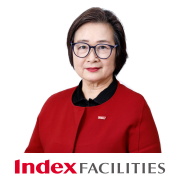We have discussed the origin of Facility Management(FM) for few times in the previous lectures.
A few days before, there was a chance to recount the history of FM and it seems that even people who are currently involved in FM are surprisingly unaware of its history, so I would like to introduce some of it to you in between case studies.
FM originated in the U.S.
The term "Facilities management" was coined in the late 1960s in the U. S.
It started as office planning and campus management. After expanding the practices at all kinds of enterprises and universities, the Facility Management Institute(FMI) was initiated during a 1979 conference sponsored by Herman Miller-furniture manufacturer in Michigan.
The author had the experience of visiting Herman Miller in 1992 and interviewing one of the researchers.
In 1976, three years after the establishment of FMI, IFMA was established as a professional association of facility managers in each company, and the above activities of FMI were dissolved.
On the other hand, Cornell University, where the author studied, was the first university in the world to systematize FM academically and establish a graduate course (Facility Planning & Management: FPM).
Late-round the 1970s, FM activities began to spread in European countries, especially in the United Kingdom and the Netherlands, in companies and universities.
How did FM start in Japan?
I remember one rainy afternoon in the summer of 1986 when one of the conference rooms at the Ikebukuro Sunshine was sweltering and overflowing with people. I forget the official name of the symposium, but I think it was called something like "A Report on an Inspection Tour of Intelligent Buildings in the United States."
The first time "FM" was publicly introduced in Japan was at the symposium held by the Delphi-lab, Inc. There were few people FM related, including me shared the same memories, so I am sure of it.
The previous year, in 1985, a survey team led by Professor Soichiro Okishio of the Tokyo University of Science visited the U.S. for the "Second Intelligent Building Survey Research" and the World Bank offices in New York. Japanese architects and other professionals were astonished to see how the user side is using CAD-based CAFM to manage office facilities. A report on this visit was presented at the symposium, and FM was introduced to Japan for the first time in 1986.
Of course, likely, FM was already being practiced in the Japanese offices of foreign companies under instructions from their headquarters. Nevertheless, this symposium was the first time FM was introduced to companies and organizations in Japan.
Subsequent FM movements in Japan
Following that, Mr. Yoshiaki Ogura from Nikken Sekkei Ltd., Mr. Hiroyoshi Murata from Itoki Corporation, and others participated in research and educational activities.
The following year, 1987, saw the start of preparatory activities for the establishment of the FM Association.
It was not until 1990 that Japanese companies introduced FM methods into office management. Mr. Mototsugu Nakatsu of IBM Japan became an opinion leader, and from around 1987, a "Japanese-style FM system" was gradually developed, and the groundwork was laid around 1991-92.
Meanwhile, just around the same time, in response to criticism from the West that Japan's rapid growth was based on rabbit-hole housing and working environments, the Ministry of International Trade and Industry (now the Ministry of Economy, Trade and Industry) led a committee to promote new offices in 1986, and in 1988 the "Guidelines for New Office" were published. (Note)
In conjunction with the promotion of the new office, office furniture manufacturers began to take action to utilize FM in the office. Around this time, many companies began publishing magazines (such as Kokuyo ECCIFO and Itoki Office Age) that introduced FM and FM methodologies used by U.S. companies.
Thus, "FM for office" became the mainstream FM in Japan, while "New Office" and "FM" were promoted at the same time.
The Japan Facility Management Association (JFMA), the New Office Promotion Association (NOPA), and the Building and Equipment Long-life Cycle Association (BELCA) jointly organized The Certified Facility Manager Qualification System, which has been implemented annually since 1997. It is mainly for in-house facility managers in offices as well.
Although FM was adopted in some hospitals and universities, it was rarely expanded.
Latest worldwide FM Movements
Nowadays, worldwide FM extends to all facilities owned or used by organizations like hospitals, schools, train stations, airports, government buildings, commercial facilities, offices, etc. The recently established global FM standard ISO 41000 (ISO FM) also stands on this basis.
On a broader perspective, roads, bridges, and other assets, as well as urban development, are also increasingly being considered FM targets. Meanwhile, the scope of FM is expanding to include not only so-called central offices but also satellite offices, co-working offices, and home offices for working at home, which have rapidly become a reality with the Corona.
Note: New Office Promotion
In the mid-1980s, Japan's rapid economic growth was being criticized in the West for having come at the expense of people's lives, as evidenced by economic friction such as the Japan-U.S. trade dispute over automobile export negotiations and criticism of Japan's living environment as a "rabbit-hole". In addition, despite the rapid shift of the economy to software and services and the fact that half of all workers, or 30 million people, are now office workers, the importance of the office was not yet well understood, as the emphasis tended to be placed solely on the factory, the site of production. It was also a time when copy machines, fax machines, word processors, etc. were introduced into offices, and the so-called "office automation" movement was underway.
The then Ministry of International Trade and Industry (now the Ministry of Economy, Trade and Industry) launched the New Office Promotion Committee in 1986 and began to improve the office environment, with "comfort and affluence" as the primary policy theme and to fend off criticism from other countries as well as expanding domestic demand.
In 1987, the New Office Promotion Association (NOPA) was established, and in 1988, the "Guidelines for the New Office" were published, and the first Nikkei New Office Award was launched under the joint sponsorship of NOPA and the Nikkei Shimbun.


